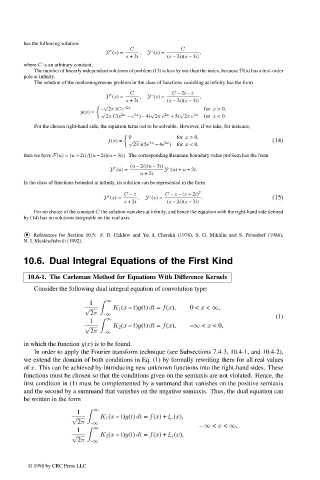Page 532 - Handbook Of Integral Equations
P. 532
has the following solution:
C C
+
–
Y (z)= , Y (z)= ,
z +2i (z – 2i)(z – 3i)
where C is an arbitrary constant.
The number of linearly independent solutions of problem (13) is less by one than the index, because D(u) has a first-order
pole at infinity.
The solution of the nonhomogeneous problem in the class of functions vanishing at infinity has the form
C C – 2i – z
+
–
Y (z)= , Y (z)= ,
z +2i (z – 2i)(z – 3i)
√
– 2πiCe –2x for x >0,
y(x)= √ √ √
3x
2πC(e 2x – e ) – 4i 2πe 2x +5i 2πe 3x for x <0.
For the chosen right-hand side, the equation turns out to be solvable. However, if we take, for instance,
0 for x >0,
f(x)= √ (14)
2x
2πi(5e 3x – 4e ) for x <0,
then we have F(u)=(u +2i)/[(u – 2i)(u – 3i)]. The corresponding Riemann boundary value problem has the form
(u – 2i)(u – 3i)
+
–
Y (u)= Y (u)+ u +2i.
u +2i
In the class of functions bounded at infinity, its solution can be represented in the form
C – z C – z – (z +2i) 2
+
–
Y (z)= , Y (z)= . (15)
z +2i (z – 2i)(z – 3i)
For no choice of the constant C the solution vanishes at infinity, and hence the equation with the right-hand side defined
by (14) has no solutions integrable on the real axis.
•
References for Section 10.5: F. D. Gakhov and Yu. I. Cherskii (1978), S. G. Mikhlin and S. Pr¨ ossdorf (1986),
N. I. Muskhelishvili (1992).
10.6. Dual Integral Equations of the First Kind
10.6-1. The Carleman Method for Equations With Difference Kernels
Consider the following dual integral equation of convolution type:
∞
1
√ K 1 (x – t)y(t) dt = f(x), 0 < x < ∞,
2π –∞
(1)
1 ∞
√ K 2 (x – t)y(t) dt = f(x), –∞ < x <0,
2π –∞
in which the function y(x) is to be found.
In order to apply the Fourier transform technique (see Subsections 7.4-3, 10.4-1, and 10.4-2),
we extend the domain of both conditions in Eq. (1) by formally rewriting them for all real values
of x. This can be achieved by introducing new unknown functions into the right-hand sides. These
functions must be chosen so that the conditions given on the semiaxis are not violated. Hence, the
first condition in (1) must be complemented by a summand that vanishes on the positive semiaxis
and the second by a summand that vanishes on the negative semiaxis. Thus, the dual equation can
be written in the form
1 ∞
√ K 1 (x – t)y(t) dt = f(x)+ ξ – (x),
2π –∞
∞ – ∞ < x < ∞,
1
√ K 2 (x – t)y(t) dt = f(x)+ ξ + (x),
2π –∞
© 1998 by CRC Press LLC
© 1998 by CRC Press LLC
Page 514

